Young People in Scotland Survey 2021: attitudes to violence against women and girls
Pupils across 50 state secondary schools were surveyed on their attitudes towards topics relating to violence against women and girls. The report examines how attitudes have changed since the first publication in 2014 and discusses differences in views across a range of equality characteristics.
Results
Domestic abuse
Physical violence
Two of the presented scenarios in the survey looked at attitudes to domestic abuse within a marriage. The first domestic abuse scenario covered physical violence:
"Imagine a married couple who have been together for a while. One evening the man's wife tells him she has been having an affair. He has never hit her before, but he responds to this news by slapping her in the face. Using the scale, choose one number to show what you think about the behaviour of the people in the situation described."
Pupils' responses were on a scale from 1 to 7 where 1 was 'not wrong at all' and 7 was 'very seriously wrong'. They were not asked how much harm they thought the man's behaviour caused the victim in this scenario.
As shown in Figure 1, more than three quarters (79%) of pupils in 2021 selected at least 5 on the 7-point scale (i.e. viewed the behaviour as 'wrong'), a statistically significant increase from 2014 (69%). This overall change in pupils' attitudes is driven by a change in girls where views have shifted significantly over time, whereas there has been no change over time among boys. Over 8 in 10 girls in 2021 (84%) thought the behaviour was wrong compared to 64% of boys. This is an increase from 76% among girls and from 63% among boys in 2014.

When disaggregated by religion, non-religious pupils were less likely to view the behaviour as 'wrong' (69%) compared to Christian pupils (79%). There were no significant differences by ethnicity, health status, urban/rural, or area deprivation.
Controlling behaviour
The second domestic abuse scenario covered controlling behaviour in a marriage:
"Imagine a married woman who wants to go out with her friends for a meal in the evening. When she tells her husband about it, he gets very annoyed. He tells her that he doesn't want her going out without him."
As shown in Figure 2, over three quarters (79%) of pupils in 2021 viewed controlling behaviour within a marriage as 'wrong', a significant increase from 65% in 2014.
Both girls and boys were significantly more likely to rate the behaviour of the perpetrator as 'wrong' in 2021 compared to 2014. The proportion of girls viewing the behaviour as 'wrong' increased from 73% in 2014 to 90% in 2021, and proportion of boys increased from 56% in 2014 to 68% in 2021.
As in the physical violence scenario, girls were more likely to view the behaviour as wrong compared to boys.
There were no significant differences by ethnicity, health status, urban/rural, religion or area deprivation.

The scenario on controlling behaviour was followed with a question on the perceived harm the behaviour caused the victim. Pupils answered how much harm they thought the man's controlling behaviour caused the woman on a five-point scale ranging from 'a great deal' to 'none at all'.
As shown in Figure 3, 86% of all pupils viewed the behaviour as 'harmful' to the woman (combined responses for "a great deal", "quite a lot", "some"), a significant increase from from 76% in 2014.
Girls were more likely to view the behaviour as 'harmful' compared to boys. Over 9 in 10 (92%) girls and and almost 8 in 10 (79%) boys viewed the behaviour as harmful in 2021. This is an increase from 78% of girls and 73% of boys in 2014.
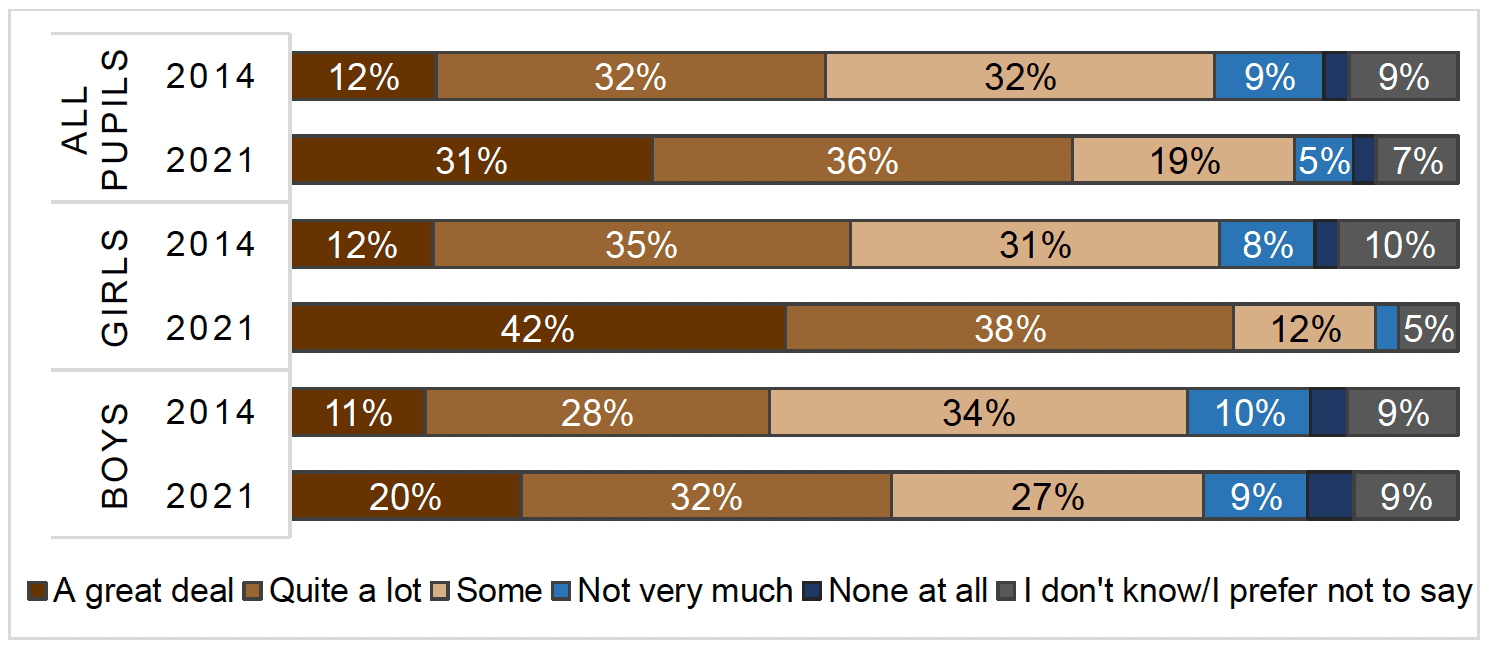
Stalking and harassment
Sending unwanted gifts
Three scenarios measured attitudes to stalking and harassment.
The first stalking and harassment scenario covered stalking by an ex-partner:
"Imagine a woman who broke up with her boyfriend a few months ago. He wants them to get back together, she does not. He has been sending flowers and gifts to her work and home even though she has told him she doesn't want them."
As shown in Figure 4, just over 6 in 10 pupils in 2021 viewed the stalking scenario as 'wrong' (62%), a significant increase from 36% in 2014. The proportions of pupils who viewed this behaviour as wrong were lower than that for the domestic abuse scenarios.
Girls were more likely to view the behaviour as 'wrong' (71%) compared to boys (52%) in 2021. The proportions of girls and boys viewing the behaviour as wrong have increased significantly from 2014 (from 35% of girls and 38% of boys in 2014).
Pupils with a long-term physical or mental health condition were more likely to rate the behaviour as wrong (69%) compared to pupils without a health condition (61%). There were no significant differences in attitudes by ethnicity, urban/rural, religion or area deprivation.

As shown in Figure 5, just over 7 in 10 (71%) pupils viewed the behaviour as 'harmful', a significant increase from 57% in 2014. This shift is primarily driven by attitudes among girls. Of girls, 83% viewed the behaviour as 'harmful' in 2021, a significant rise from 63% in 2014. Among boys, 59% viewed the behaviour as 'harmful' in 2021, a small and not statistically significant rise from 55% in 2014.
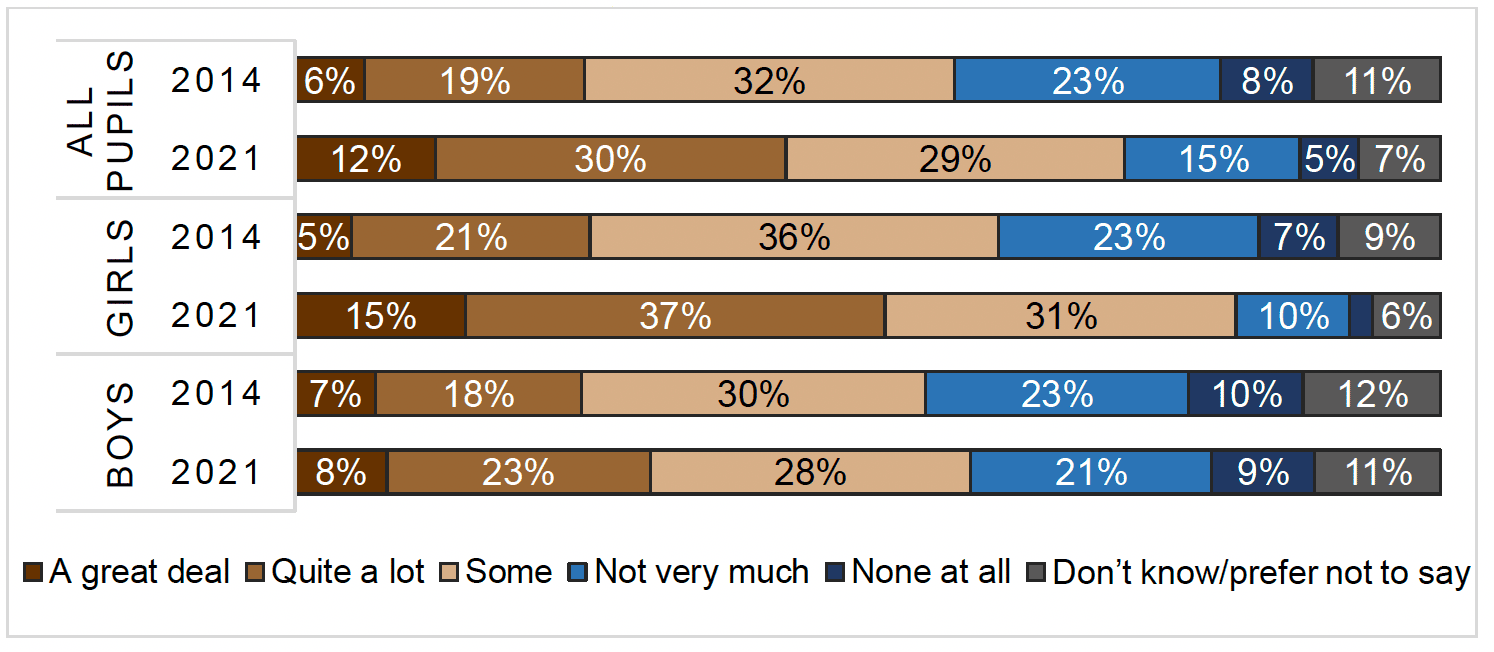
Wolf-whistling
The second stalking and harassment scenario described a group of men wolf-whistling at a woman:
"Imagine a woman is walking down the street. She passes a group of men who start wolf-whistling and saying things like ''hey sexy" to her."
As shown in Figure 6, over 8 in 10 (84%) pupils viewed this behaviour as wrong. This is a significant increase from almost 6 in 10 pupils (56%) in 2014.
There was a substantial and significant increase in the proportions of both girls and boys who viewed the behaviour as 'wrong' between 2014 and 2021. Over 9 in 10 (95%) girls viewed the behaviour as 'wrong' in 2021, an increase of 32 percentage points compared to 2014 (63%). Likewise, more than 7 in 10 boys viewed the behaviour as wrong in 2021, a rise of 25 percentage points compared to 2014 (49%).
As for the domestic abuse and other stalking and harassment scenarios, girls were more likely than boys to view the behaviour as wrong.
There were no significant differences by ethnicity, health status, urban/rural, religion or area deprivation.

Pupils were asked about the harm they though a group of men wolf-whistling at a woman passing by would cause her and answered on a five-point scale ranging from 'a great deal' to 'none at all'.
As shown in Figure 7, just over 8 in 10 pupils (83%) in 2021 viewed the behaviour as 'harmful', a significant increase from 54% in 2014. A greater proportion of girls and boys viewed the behaviour as harmful in 2021 (92% and 71%, respectively) than in 2014 (63% and 50%, respectively). The largest attitudinal shift over time has occurred among girls.
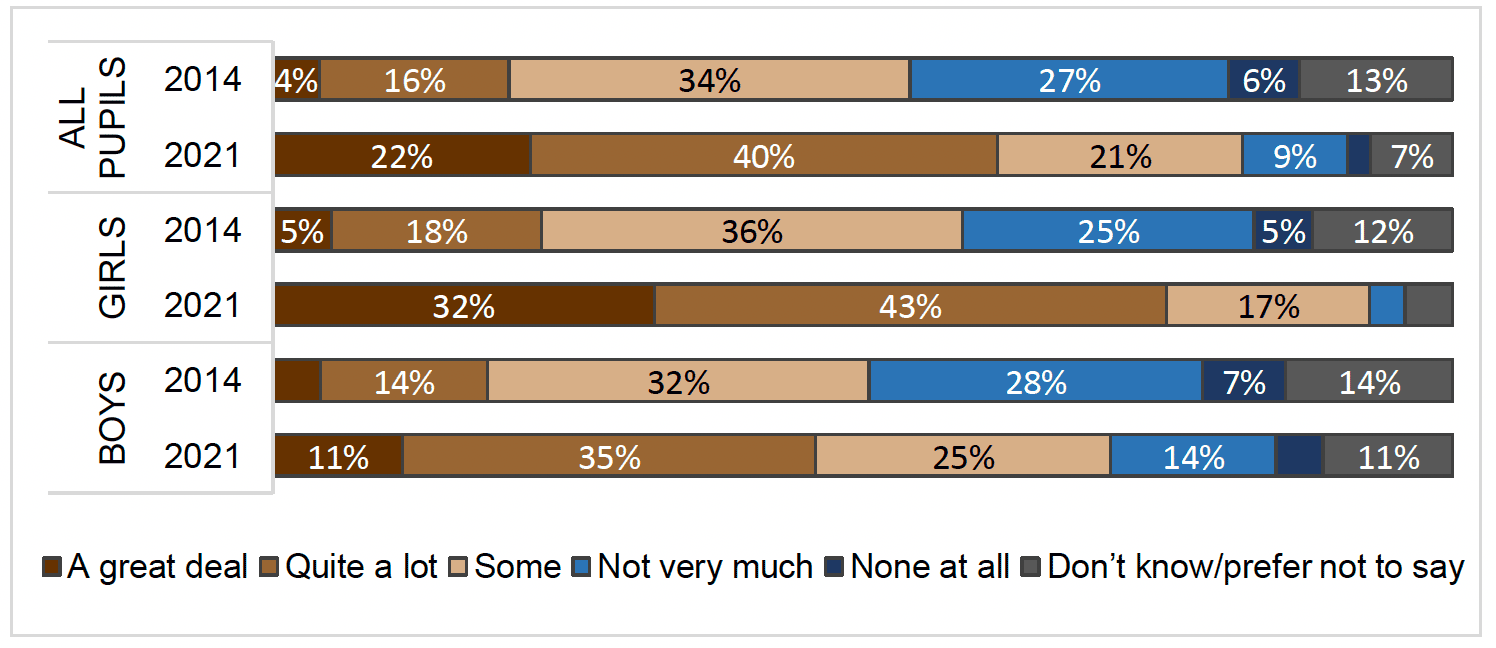
Sharing naked photos online without consent
The third stalking and harassment scenario pupils responded to was non-consensual sharing of naked images online:
"Imagine a woman sent some naked photos of herself to her boyfriend. After they split up, he puts them on the internet without telling her, so that anyone could see them."
As shown in Figure 8, over 9 in 10 pupils (94%) rated this behaviour as 'wrong', a small but significant increase from 89% in 2014. Unlike the other scenarios, this increase is driven by an attitudinal change among boys, not girls.
In 2021, 91% of boys rated this behaviour as wrong compared to 85% of boys in 2014. While girls were more likely than boys to view the behaviour as 'wrong' in 2021 and 2014, there was no change in girls' attitudes over time.
There were no significant differences by ethnicity, health status, urban/rural, religion or area deprivation.

There was also a small but significant rise in the proportion of pupils who viewed the behaviour as 'harmful' from 91% in 2014 to 95% in 2021. As with views on how wrong this behaviour is, this attudinal change over time is driven mainly by a shift in views of boys.
Ninety-two percent of boys thought this behaviour was harmful, compared to 87% in 2014. There was no significant change in the proportion of girls who viewed the behaviour as 'harmful' between 2021 and 2014.
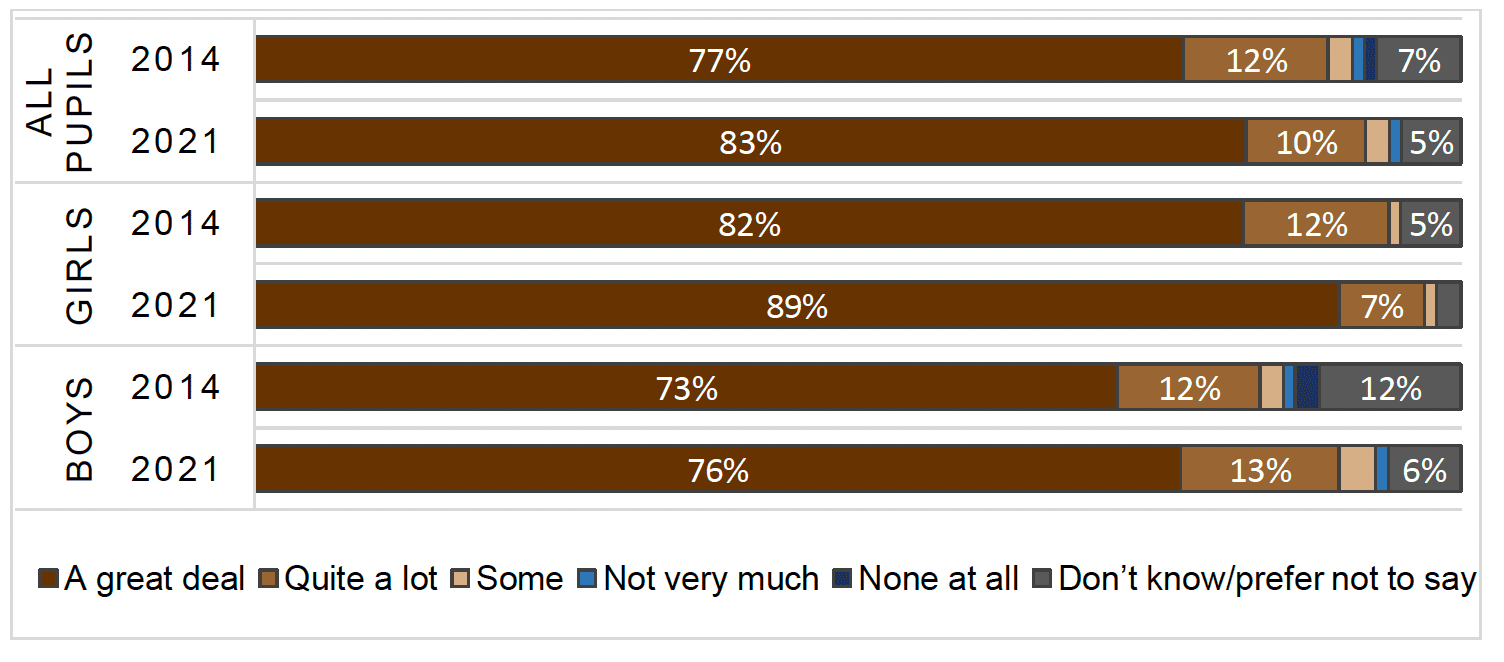
Commercial sexual exploitation
Pornography
Commercial sexual exploitation includes a wide range of often linked sexual activities, which (typically) men profit from or buy from women, and which objectify and cause harm to women. Pupils from S4 to S6, aged between 14 and 18 were asked about two forms of commercial sexual exploitation.
The first commercial sexual exploitation scenario involved an individual watching pornography at home:
"How wrong do you personally think it is for an adult (18 or over) to watch pornography at home, or is it not wrong at all?"
The content of this question in 2021 changed from the original question in 2014 ("How wrong do you personally think it is for an adult (18 or over) to read magazines that feature topless women, or is it not wrong at all?"). This means that a comparison of attitudes between 2021 and 2014 is not possible.
As shown in Figure 10, 16% of all pupils viewed the behaviour described in the scenarios as 'wrong'. A greater proportion of girls viewed the behaviour as 'wrong' (19%) compared to boys (15%).
There was also a significant difference in views among pupils with a Christian faith compared to pupils with no religion. Just under a third of Christian pupils viewed the behaviour as 'wrong' (29%) compared to 11% of non-religious pupils.
There were no significant differences by ethnicity, health status, urban/rural, or area deprivation.
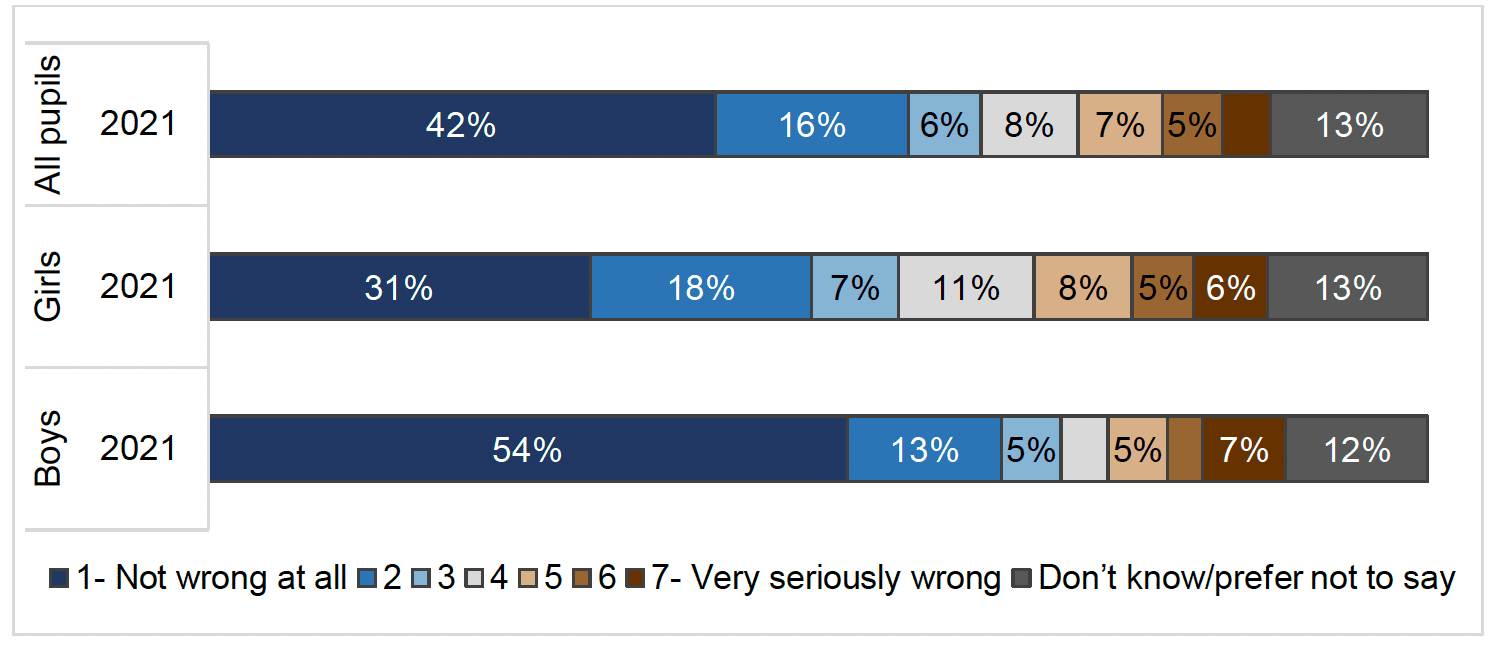
Visiting a strip club
The second commercial sexual exploitation scenario involved men visiting a strip club to watch naked women:
"How wrong do you personally think it is for a group of men (18 or over) to go to a strip club to watch naked women, or is it not wrong at all."
Just under a quarter of all pupils viewed the behaviour described in the scenario as 'wrong' (23%) in 2021, which is comparable to the proportion of pupils who viewed the behaviour as 'wrong' in 2014 (24%). Unlike boys, there was a significant decrease in the proportion of girls who thought the behaviour was wrong in 2021 (28%) compared to 2014 (39%).
As for the pornography scenario, there was a significant difference in the attitudes of non-religious pupils and those of Christian faith. Christian pupils were more likely to rate this behaviour as wrong (41%) compared to non-religious pupils (16%).
There were no significant differences by ethnicity, health status, urban/rural, or area deprivation.

Gender stereotypes
Boy picks a princess doll
Stereotypical views on gender roles were measured by pupils' willingness, or otherwise, to buy a toy for a young child that is not traditionally associated with the child's gender. Pupils were presented with two scenarios where a 3-year-old child was asking for a toy less common for their gender and were asked how they would respond. The options included a non-stereotypical response ("buy the toy without saying anything") and two stereotype-affirming responses ("buy it but first try to get him/her to pick a toy more common for boys/girls" and "make him/her put back the doll/truck and pick a toy more common for boys/girls") or I don't know/prefer not to say. This section examines the scenario of a boy picking a princess doll:
"Imagine you are taking a 3-year-old boy to a shop to buy a toy. When you get there, he picks a princess doll. Which of the phrases below best describes what you would do?"
As shown in Figure 12, a significant change in the attitudes of all pupils has occurred since the previous survey in 2014:
- 71% of the pupils said they would "buy the toy for him without saying anything" (an increase from 40% in 2014)
- 15% would "buy it but first get him to pick a toy more common for boys" (a decrease from 34% in 2014)
- 7% would "make him put the doll back and pick a toy more common for boys" (a decrease from 15% in 2014)
The same significant increase over time was evident when the results were disaggregated by gender too:
- 87% of girls in 2021 reported they would "buy the toy for him without saying anything" (an increase from 52% in 2014)
- 54% of boys in 2021 said they would "buy the toy for him without saying anything" (an increase from 29% in 2014)
- 1% of girls and 12% of boys said they would "make him put the doll back and pick a toy more common for boys" (a decrease from 6% and 23% respectively in 2014)
In both years girls were more likely to buy the toy without saying anything and less likely to refuse to buy the toy compared to boys.
Views on this scenario differed by religious identity and health condition:
- non-religious pupils were more likely to buy the princess doll without saying anything (76%) compared to pupils of any Christian faith (66%)
- Christian pupils were also more likely to refuse to buy the toy altogether (12%) compared to non-religious pupils (5%)
- pupils with a long-term physical or mental health condition were more likely to buy the toy without saying anything (77%) compared to those without a long-term health condition (68%)
There were no significant differences by urban/rural or area deprivation. The sample size was too small to examine differences by ethnicity.

Girl picks a toy truck
The second scenario on gender stereotypes involved a girl picking a toy truck:
"Imagine you are taking a 3-year-old girl to a shop to buy a toy. When you get there, she picks a toy truck. Which of the phrases below best describes what you would do?"
Like the scenario involving a boy picking a princess doll, a significant shift in attitudes occurred between 2014 and 2021:
- 79% of pupils said that they would "buy the toy without saying anything" (an increase from 53% in 2014)
- 12% of pupils said they would "buy it but first try to get her to pick a toy more common for girls" (a decrease from 30% in 2014)
- 3% of pupils said they would "make her put the truck back and pick a toy more common for girls" (a decrease from 8% in 2014)
When disaggregated by gender, it is evident that this overall change in attitudes is driven by a shift in boys' views but not those of girls:
- 67% of boys in 2021 said they would "buy the toy without saying anything" (an increase from 46% in 2014)
- 17% of boys said that they would "buy it but first try to get her to pick a toy more common for girls" (a decrease from 31% in 2014)
- 6% of boys said they would "make her put the truck back and pick a toy more common for girls" (a decrease from 11% in 2014)
The views of girls did not change significantly over time:
- nearly 9 in 10 selected they would buy the toy in both years (87% in 2021 and 89% in 2014)
- under 1 in 10 refused to buy the toy in both years (9% and 8%, respectively)
Looking at the gender stereotype scenarios together, boys were much more accepting of a girl picking a toy truck and less accepting of a boy picking a princess doll in both 2014 and 2021, while girls have become equally accepting of both scenarios over time.
A significant difference in attitudes was also observed in the breakdown by religion. Just over 8 in 10 (83%) non-religious pupils reported they would buy the toy without saying anything, compared to just over 7 in 10 pupils of a Christian faith (74%)
There were no significant differences by health condition, urban/rural or area deprivation. The sample size was too small to examine differences by ethnicity.
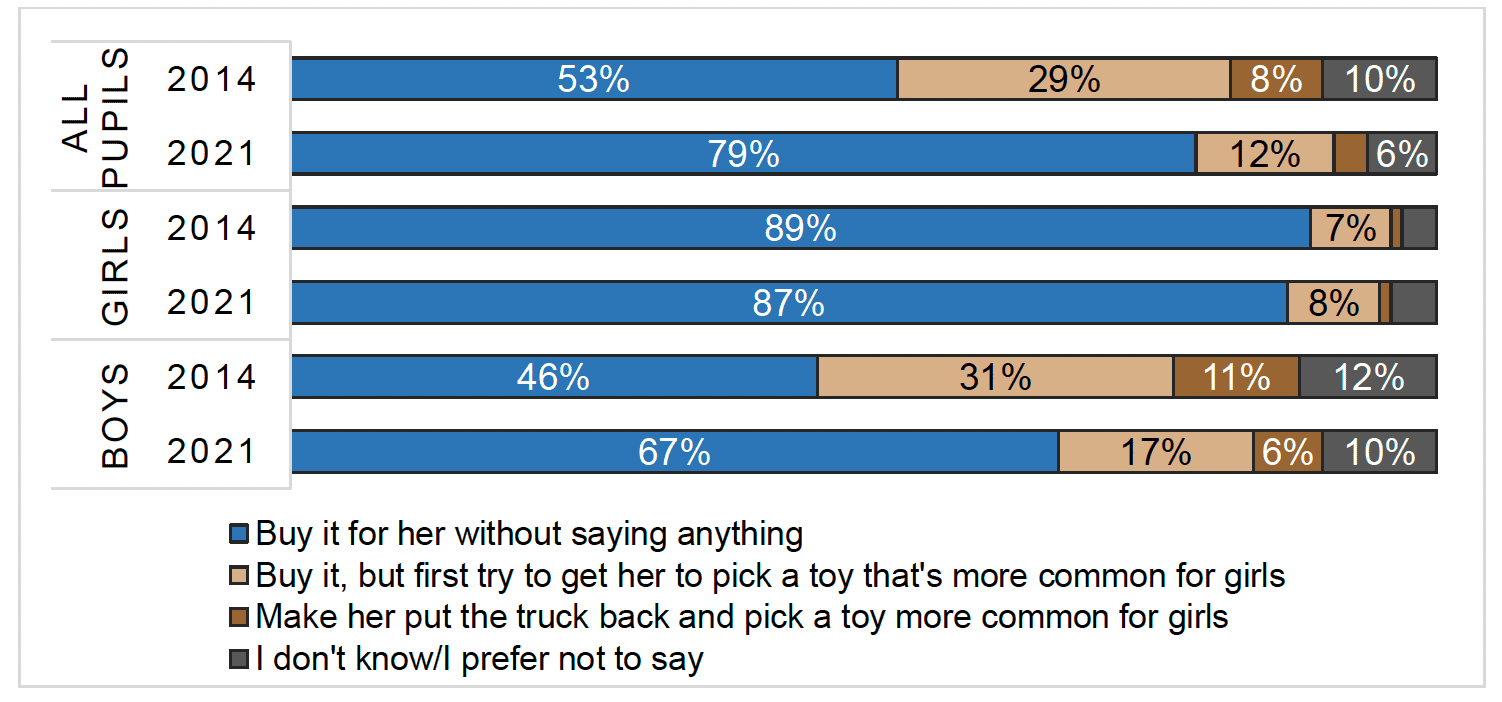
Contact
There is a problem
Thanks for your feedback